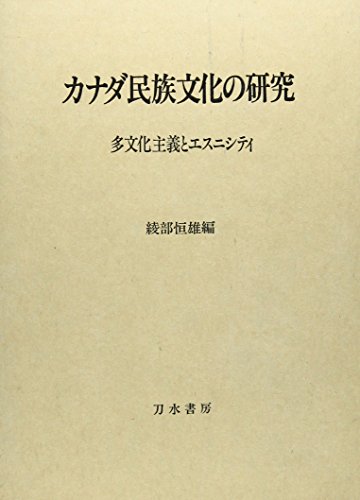2 0 0 0 カナダ民族文化の研究 : 多文化主義とエスニシティ
3年間の研究・調査の結果、次のような成果を得たと考える。(1)研究対象となった3ケ国の多文化主義は、"美しい"理念から出発したというよりも、国民国家統合上の政策として登場したものである。(2)3ケ国とも、元イギリスの植民地であり、民主主義と議会政治の伝統を受け継いでいる。(3)多文化主羲の台頭は、人権思想、反人種主義、文化相対主義思想の滲述と深く関わっている。(4)3ケ国の先住民(イヌイット、ネイティブ・アメリカン、アボリジニ)は多文化主義に反対している。(5)多文化主義の理念は、国民国家の統合を破壊する'危険'を、常にはらんでいる。(6)20世紀末から加速した、グローバライゼーシヨンは、英語の使用、アメリカ的価値組の普及をもたらし、結果として多文化主義思考を弱体化し、同化志向価値を助長する。(7)多文化主義が国民国家内で一定の成果をあげた場合でも、異文化間にみられるジェンダーの相違、宗教思想(例えば、キリスト教団におけるイスラム教徒)の違いをどのように扱うかという困難な問題が残されよう。(8)現在、世界各国で視察される多文化主義は、国民国家の枠を越えることはできない。
1 0 0 0 OA ピヤ・アヌマン・ラージャトン「古シャムにおける生活と儀禮」
- 著者
- 綾部 恒雄
- 出版者
- 東南アジア学会
- 雑誌
- 南方史研究 (ISSN:2185050X)
- 巻号頁・発行日
- vol.1963, no.3, pp.75-77, 1963-08-15 (Released:2010-10-22)
- 著者
- 綾部 恒雄
- 出版者
- 東南アジア学会
- 雑誌
- 南方史研究 (ISSN:2185050X)
- 巻号頁・発行日
- vol.1960, no.2, pp.195-197, 1959-06-30 (Released:2010-10-22)
1 0 0 0 OA 系譜的諸関係よりみたラオ族の位置と變容
- 著者
- 綾部 恒雄
- 出版者
- 東南アジア学会
- 雑誌
- 南方史研究 (ISSN:2185050X)
- 巻号頁・発行日
- vol.1959, no.1, pp.17-36,A5, 1959-06-30 (Released:2010-10-22)
One of the most important peoples of the Mainland of the Southeast Asia is the Thai group widely distributed throughout the Peninsula. They exhibit a wide variety of customs characterized by extreme plasticity. Among these Thai tribes, the author deals with the Lao people, with special emphasis upon changing aspects of genealogical relationships among them.The term genealogical relationships is used here in a wide sense; it is not used solely to refer to the descent relationship regulating the membership of a particular group, but also to indicate various aspects of personal status succession among the family and kindred. In other words, this term is used as the sum of rights and obligations concerning status succession recognized by laws and customs of the society.From the above point of view, the author presented the monograph of Pha Khao village (Lao people) located in the Northern part of Vientiane where he had carried out his field work in January and February 1957. After dealing with genealogical relations among the Pha Khao inhabitants, the author then studied the same customs of the Lao people and compared their changing aspects and variation with the Pha Khao.The Pha Khao has a nuclear type of family which amounts to as high as 80% of all families; the average number in a family is 4.5 in general. Marital residence is matrilocal and kinship terminology is of the bilateral type. Teknonymy is extremely developed and it has a tendency to trace a, maternal line. Although the Lao have had no family name, they adopted the use of it in 1944 by the order of the government; this family name is now called. Nam Sa Kun, and is traced by the paternal line. Actually, this has no function in Pha Khao. The form of appellation customarily used is the addition of Nai (Mr. in English) to a male personal name or Nang (Mrs. or Miss) to a female personal name. In addition, in the case of male adults, titles indicating their grades as priests are used after their return from the priesthood. The inheritance in general is on the bilateral principle concerning sex differentiation, while the house and its building land pass from the mother to the youngest daughter. This is a kind of junior right and has some relation to the rule of matrilocal residence.In Sum at Pha Khao the family name is transmitted in paternal line and the descent has a patrilineal trend, while the house inheritance right and teknonymy are along the maternal line.Now we must compare the monograph of Pha Khao mentioned above with some customs among other Lao peoples, for instance, with Chieng Mai Lao.In Chieng Mai Province (Thailand), teknonymy has already disappeared, while Nam Sa Kun which has almost no function at Pha Khao is comparatively well developed and the appellation custom of adding Nai (Mr.) and Nang (Mrs. Miss.) before a personal name is used with the same degree as at Pha Khao. The title concerning priestly grade is not used in Chieng Mai Province.To return to the main proposition, it is needless to say that the appellation and the title are limited to one's life time and to one generation. From the genealogical point of view, it has no meaning. However, the important problem is that the appellation and the title have strong functional relations with the vicissitudes of genealogical customs. As regards inheritance, Chieng Mai Lao has the same character as Pha Khao.This article deals only with the genealogical relationship among Lao people. According to the various previous studies, the Lao have the rule of bilateral descent and their form of social structure is a horizontal one, but from the above point of view, the Lao have many genealogical principles showing many complex changes and variations among them.After consideration of the facts, we can find a trend among the Lao peoples illustrating a tendency toward similarity with the culture of Bangkok.
- 著者
- 綾部 恒雄
- 出版者
- 日本文化人類学会
- 雑誌
- 民族學研究 (ISSN:24240508)
- 巻号頁・発行日
- vol.35, no.2, pp.159-160, 1970-09-30 (Released:2018-03-27)
1 0 0 0 OA 建設的民族論のために : 名和克郎氏の批判に応える
- 著者
- 綾部 恒雄
- 出版者
- 日本文化人類学会
- 雑誌
- 民族學研究 (ISSN:24240508)
- 巻号頁・発行日
- vol.58, no.1, pp.88-93, 1993-06-30 (Released:2018-03-27)




